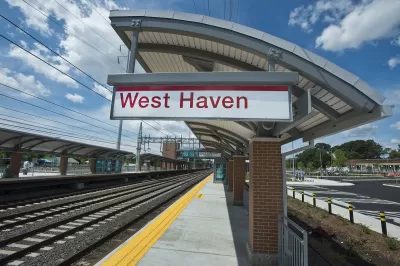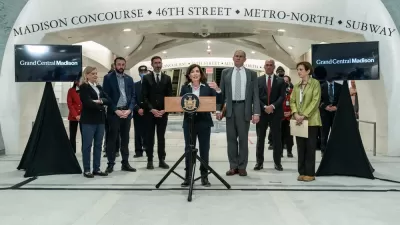Rather than bonds, an op-ed makes the case for electronic tolls to pay for improvements to commuter rail lines between New York City and Connecticut.

"Long commutes into New York City and within Connecticut mean our state is a less attractive place for people to live," writes Connecticut resident Michael Critelli. "People who travel into New York often drive and park at a train station and then get on subways or buses or walk to a workplace. As a result, their commute can now be close to two hours in each direction, four hours daily."
As maintenance and safety concerns pile up along MTA's Metro-North Railroad, Connecticut communities once within commuting distance of New York are becoming less attractive options. "Speed restrictions are in place in many locations where infrastructure is old and unreliable, where there are sharp curves and where there are bottlenecks caused by limited track capacity," Critelli writes.
Bond measures to fund rail upgrades, he goes on, aren't sustainable over the long term. "With tolling we can collect user fees from the out-of-state drivers who currently get a free ride on our highways — 40 percent of tolling revenues are expected to be collected from out-of-state drivers. Tolls can also help us reduce congestion and lower vehicle emissions."
FULL STORY: The hidden cost of slower, less reliable commuter rail service: Op-Ed

Planetizen Federal Action Tracker
A weekly monitor of how Trump’s orders and actions are impacting planners and planning in America.

Maui's Vacation Rental Debate Turns Ugly
Verbal attacks, misinformation campaigns and fistfights plague a high-stakes debate to convert thousands of vacation rentals into long-term housing.

Restaurant Patios Were a Pandemic Win — Why Were They so Hard to Keep?
Social distancing requirements and changes in travel patterns prompted cities to pilot new uses for street and sidewalk space. Then it got complicated.

In California Battle of Housing vs. Environment, Housing Just Won
A new state law significantly limits the power of CEQA, an environmental review law that served as a powerful tool for blocking new development.

Boulder Eliminates Parking Minimums Citywide
Officials estimate the cost of building a single underground parking space at up to $100,000.

Orange County, Florida Adopts Largest US “Sprawl Repair” Code
The ‘Orange Code’ seeks to rectify decades of sprawl-inducing, car-oriented development.
Urban Design for Planners 1: Software Tools
This six-course series explores essential urban design concepts using open source software and equips planners with the tools they need to participate fully in the urban design process.
Planning for Universal Design
Learn the tools for implementing Universal Design in planning regulations.
Heyer Gruel & Associates PA
JM Goldson LLC
Custer County Colorado
City of Camden Redevelopment Agency
City of Astoria
Transportation Research & Education Center (TREC) at Portland State University
Jefferson Parish Government
Camden Redevelopment Agency
City of Claremont





























